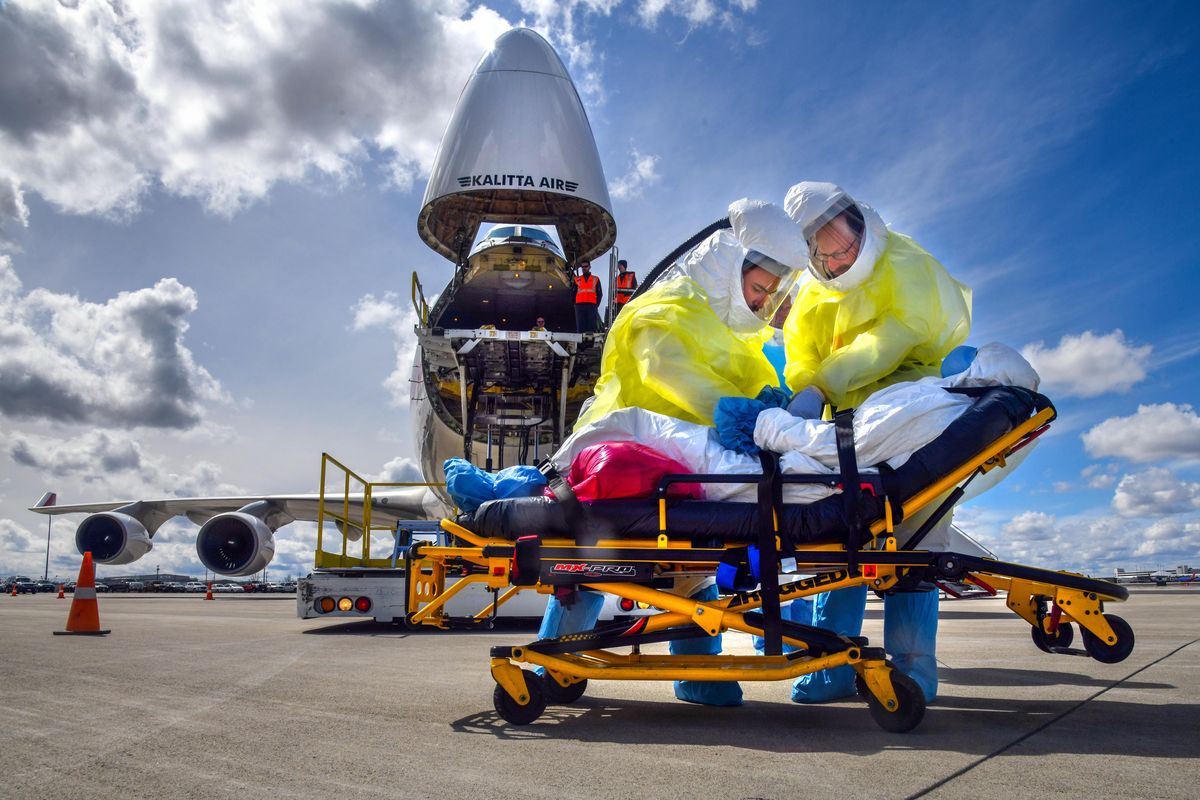Airborne ICU in 747 touches down in Spokane for nationwide Ebola drill

When health care workers in West Africa started getting Ebola during the 2014 outbreak, no one was really sure how to fly someone with a hemorrhagic fever safely across the Atlantic Ocean.
At the time, the federal government called up an old contractor, Atlanta-based Phoenix Air, and brought a system designed to isolate people with serious respiratory infections out of storage.
The result – a plastic tent inside a small Gulfstream III jet – worked to transport patients like Kent Brantly, an American doctor working in Liberia who survived Ebola after he was flown back to Atlanta for treatment.
But what if the U.S. needed to move four – or eight – people on a single flight?
Four years and a few hundred million dollars later, the U.S. Department of Health and Human Services has an answer: a really big 747 cargo plane with a self-contained intensive care unit.
On Wednesday, Spokane participated in Tranquil Terminus, a nationwide drill to test the system. It’s the first federal exercise to simulate moving multiple patients with highly infectious diseases around the country.
Vance Ferebee, a flight nurse with Phoenix Air who flew on 20 Ebola patient evacuations from West Africa, was on hand supervising the patient transfers from the plane.
“I like wearing flight Tyvek,” he joked, referring to the plastic suits worn by medical workers caring for Ebola patients.
Why Spokane? It’s home to one of just 10 hospital units in the U.S. designed to care for patients with highly infectious diseases like Ebola. Completed in 2017, the special pathogens unit at Providence Sacred Heart Medical Center can care for up to two Ebola patients, or 10 patients with less-serious infectious diseases.
Four mock patients were identified and processed at two hospitals in Boise before the converted Boeing 747 took off for Spokane International Airport. Though Spokane doesn’t have regular passenger flights on 747s, it’s equipped to land large planes for passenger flight diversions, airport spokesman Todd Woodard said.
Once on the tarmac, two of the patients were transferred to ambulances bound for Sacred Heart. A lift carried them from the nose of the plane to the ground.

The other two patients departed by air for Cedars-Sinai Medical Center in Los Angeles, home to another special pathogens unit.
The interior of the plane is largely empty except for a big metal container that Ferebee calls “the pod.”
Officially known as a “containerized biological containment system,” it’s a three-room intensive care unit in a box. Only two exist in the world, and both were on the plane Wednesday: one to transport the mock patients, and the other left empty for tours and testing.
The doors, complete with ominous red handles, look like something out of a zombie apocalypse movie.
“No one leaves the box once the trip begins,” Ferebee said.
The largest room in the pod, closest to the nose of the plane, is for patient care. Four stretchers are set up, each with a jump seat behind for a flight nurse or paramedic. A shelf above the cots can hold ventilators and other medical equipment.
Air is double-filtered before it goes in and twice more before it re-enters the cabin, preventing pathogens from getting out.
The entire space has negative air flow, meaning when the door is open, air flows from the cabin into the pod, rather than the other way. It’s a safety design measure typical in medical labs and hospitals caring for patients with highly infectious diseases.

A small middle room within the pod helps medical workers transition between the “hot” zone, where patients are, and the “cool” zone: a break room in back with snacks, a camp toilet and extra protective equipment. Decontamination can take about an hour, with one worker reading directions out loud as another takes off equipment to ensure no steps are missed.
During a real flight, Phoenix Air would operate the evacuation. But members of the U.S. Public Health Service were on hand Wednesday to evaluate the patient transport plans and make sure everything worked as planned.
Capt. John Smart, the regional emergency coordinator for the public health service’s Pacific Northwest branch, said aside from a few hiccups coordinating among HHS regions, the exercise was running according to plan.
‘For the most part, it’s been working,” he said.
Though Ebola is the simulated disease for this exercise, the same protocols would be used for an outbreak of any highly infectious disease, including drug-resistant tuberculosis and monkeypox. Modifications would be made as needed, depending on how the disease spreads.
As with all disaster preparedness equipment, the hope is that it never needs to be used.
“It could be you take your grandkids to the Air and Space Museum and this thing is off in the corner,” Ferebee said.